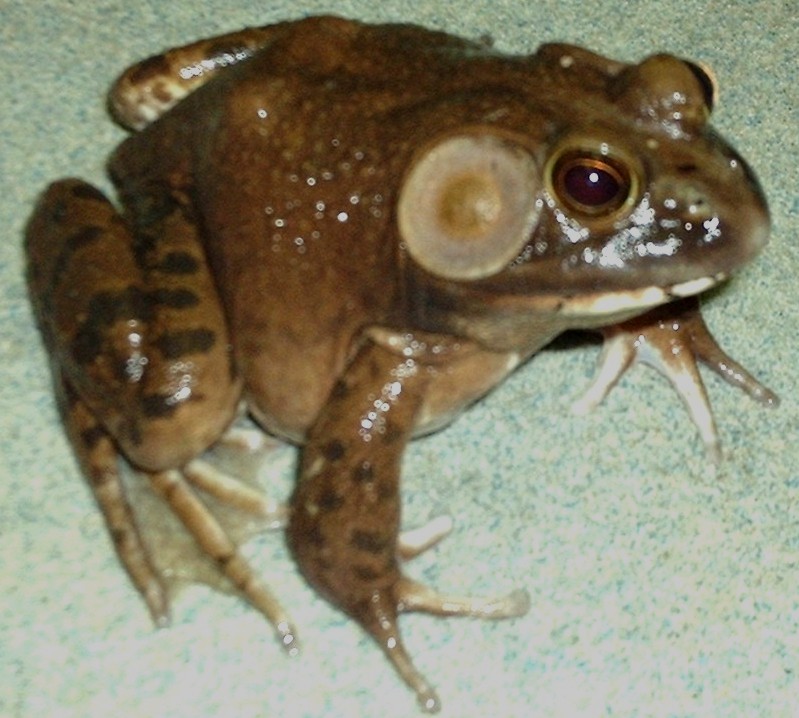Andrea Simmons - Andrea_Simmons@brown.edu
Dianne Suggs - Dianne_Suggs@brown.edu
Dept. of Psych.
Brown University
Providence, RI 02912
Popular version of paper 1aAB9
Presented Monday morning, May 24, 2004
147th ASA Meeting, New York, NY
Summary: What does a frog's stutter sound like and why does it happen? Short gaps in a frog's normal call may act as a way to attract mates. Researchers studied frogs that make stutters to find out when, why and in what sequence they made the noises.
Sometimes the acoustic makeup of a sound tells the listener more about the sender than the contents of the message. Animals use sounds to identify species and individuals, announce their social status, their biological fitness, and even their readiness to mate or fight. Some species have evolved large, complex vocabularies to communicate, while others say a lot with very limited numbers of calls. A fundamental question in the study of communication by sound is "How much information can a sender convey in a single signal?"

The bullfrog (Rana catesbeiana) offers an ideal model with which to investigate
this question. A male bullfrog's advertisement call attracts females for mating,
maintains territorial boundaries with other males and also indicates that he
is healthy and aggressive.
How does an individual male accomplish such variability, and how do receivers
(other males and females) distinguish between different messages in the same
vocalization?
The advertisement call of the male bullfrog consists of a sequence of individual
croaks. These are generated by the abdominal and laryngeal muscles repeatedly
forcing air between the lungs and vocal sac. Figure 1 is a digitized oscilloscope
tracing of an individual frog's call, recorded in a natural chorus.
 |
It is clear that the six croaks in Figure 1 have different shapes. Although the first croak has a somewhat smooth progression, the other five contain what appear to be gaps or notches. When listening to the call, it becomes apparent that each of these gaps produces a sort of hesitation within a croak. It is for this reason we have termed the gaps "stutters"
| Listen to a bullfrog call with stutters |
| Description of the sound: This particular male's calls consists of 8
individual croaks. Notice how the characteristics of each individual croak changes over the course of the call. The first 2 croaks
are smooth and unmodulated. In the third croak, we hear a change-- it now appears
to consist of 2 croaks; we call this change in the croak the "stutter."
This particular croak by our definition has one stutter (one change in the envelope).
The fourth, fifth and sixth croaks have 2 stutters, while the seventh croak
has 3 stutters. |
We found that the male bullfrog follows several rules when adding stutters to his call. We recorded 2,536 calls containing stutters from bullfrogs in natural choruses. For each call, we analyzed the number of croaks and the number of stutters within each croak. There appear to be three simple rules that govern the number of stutters contained within each of the croaks in a call. These rules are:
1. All calls begin with a croak that contains no stutters.
2. When stuttering starts, it does so within a croak that contains one stutter only.
3. When a change in the number of stutters occurs from one croak to the next in a call, it does so with an increase or a decrease of one stutter only.
Frogs seemed to be adhering to the rules quite closely. Of the 2,536 stuttered
calls analyzed, 100% began with a croak containing no stutters, 91.9% followed
the "stuttering begins with one stutter" rule, and 97.4% followed
the "plus or minus one stutter" rule. This stuttering pattern was
consistent across the 32 individual males studied, as well as across the 17
choruses and three breeding sites. Although calling costs the frog energy, stutters
don't happen simply because the frog is physically fatigued --- the call is
strong throughout. If the frog were simply "running out of breath,"
a less structured pattern of stuttering would be expected. Furthermore, you
would expect an increase in stuttering during the nightly chorus, as well as
across the breeding season; however, our data did not support this prediction
for individual frogs or for chorus activity as a whole. One possibility is that
inserting the stutters in the call allows the frog to extend the length of his
individual calls while reducing the amount of air exchange needed, similar to
what occurs when opera singers insert tremolos in extended notes.
To determine how a frog's stutter affects the calls of other frogs in the chorus,
we conducted an experiment in which pre-recorded calls, stuttered and non-stuttered,
were played through a loudspeaker to individual males. Frogs whose territories
were closest to the loudspeaker responded to both stuttered and non-stuttered
calls with different types of reactions: one croak/no stutter calls, multiple
non-stuttered croaks, aggressive displays, or physical attacks. Frogs whose
territories were further from the speaker responded with more stutters in their
calls to the stuttered stimuli than to the non-stuttered stimuli. Our results
suggest that non-stuttered calls are used for aggressive or territorial purposes,
while stuttered calls are not. Therefore, it is possible that stuttering is
somehow involved in mate attraction. Additional experiments, particularly those
involving female mate choice, are necessary to better understand the role stuttering
may play in the communication system of the bullfrog.